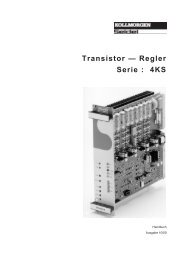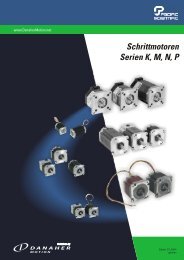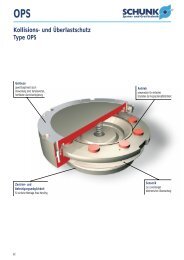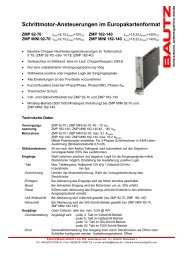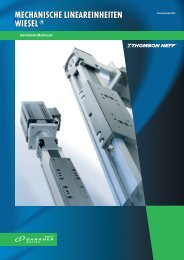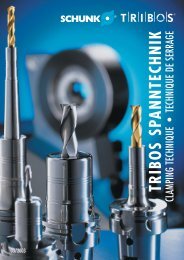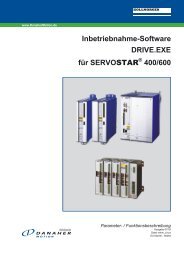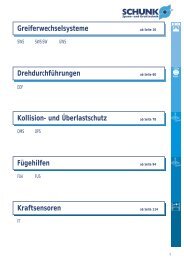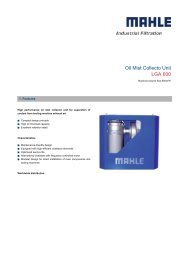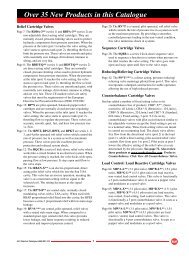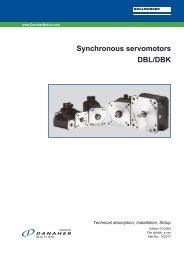Digital Servo Amplifier SERVOSTAR 400 - BIBUS SK, sro
Digital Servo Amplifier SERVOSTAR 400 - BIBUS SK, sro
Digital Servo Amplifier SERVOSTAR 400 - BIBUS SK, sro
Create successful ePaper yourself
Turn your PDF publications into a flip-book with our unique Google optimized e-Paper software.
Kollmorgen 07/03 Installation<br />
2 Installation<br />
2.1 Important notes<br />
� Protect the servo amplifier from impermissible stresses. In particular, do not let any components<br />
become bent or any insulation distances altered during transport and handling. Avoid<br />
contact with electronic components and contacts.<br />
� Check the combination of servo amplifier and motor (� p.72). Compare the rated voltage<br />
and current of the units. Carry out the wiring according to the instructions on Page 26.<br />
� Make sure that the maximum permissible rated voltage at the terminals for L1, L2, L3 and<br />
+RBext, –DC is not exceeded by more than 10%, even in the most unfavourable conditions<br />
(see EN 60204-1 Section 4.3.1). An excessive voltage on these terminals can lead to destruction<br />
of the regen circuit and the servo amplifier.<br />
Use the <strong>SERVOSTAR</strong> 44x only on an earthed 3-phase supply system. Use the amplifier only<br />
to drive a synchronous servomotor.<br />
� The fusing of the AC supply input and the 24V supply is installed by the user (� p.18).<br />
� Take care that the servo amplifier and motor are properly earthed. Do not use painted<br />
(non-conductive) mounting plates.<br />
� Route power and control cables separately. We recommend a separation of at least 20 cm.<br />
This improves the interference immunity required by EMC regulations. If a motor power cable<br />
is used which includes cores for brake control, the brake control cores must be separately<br />
shielded.<br />
Earth the shielding at both ends (� p.28).<br />
� Install all heavy-current cables with an adequate cross-section, as per EN 60204-1<br />
(� p.18).<br />
� Wire the BTB/RTO contact in series into the safety circuit of the installation.<br />
Only in this way is the monitoring of the servo amplifier assured.<br />
� Install all shielding with large area (low impedance) connections, with metallised connector<br />
housings or shield connection clamps where possible.<br />
Notes on connection techniques can be found on Page 32 and the Application Note “Cables<br />
& Connectors”.<br />
� Ensure that there is an adequate flow of cool, filtered air into the bottom of the switchgear<br />
cabinet. Note the conditions on Page 18 .<br />
� It is permissible to alter the servo amplifier settings by using the operator software.<br />
Any other alterations will invalidate the warranty.<br />
Caution<br />
Never disconnect the electrical connections to the servo amplifier while it is live.<br />
In unfavourable circumstances this could result in destruction of the electronics.<br />
Residual charges in the capacitors can have dangerous levels up to 300 seconds after<br />
switching off the mains supply voltage. Measure the voltage in the DC-link<br />
(+RBext/-DC) and wait until the voltage has fallen below 40V.<br />
Control and power connections can still be live, even when the motor is not rotating.<br />
<strong>SERVOSTAR</strong> ® <strong>400</strong> Installation manual 23




